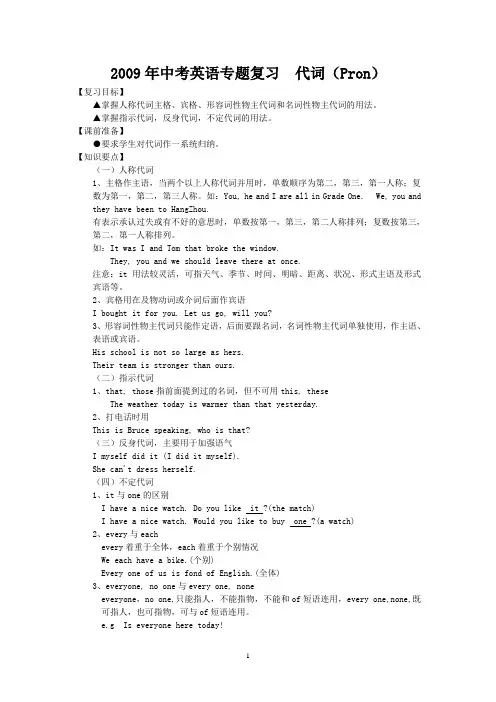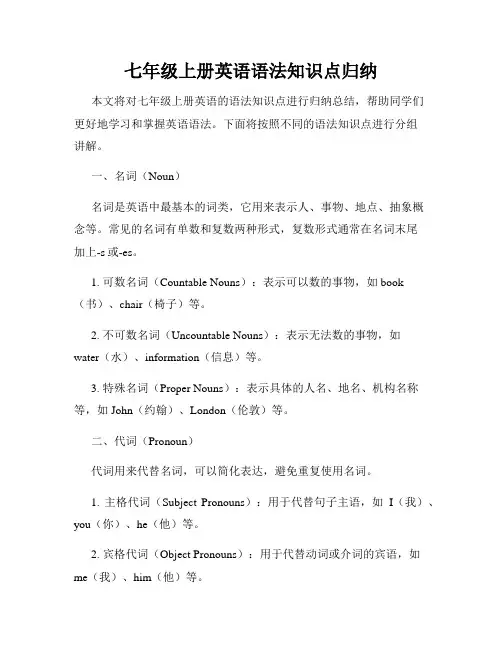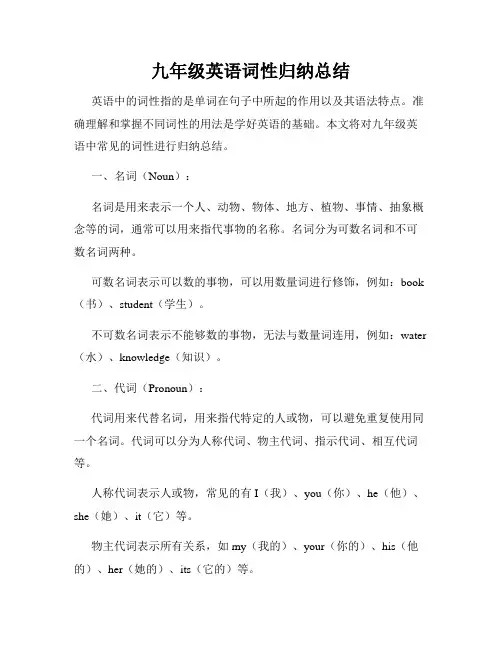Pron.初中语法-代词
- 格式:doc
- 大小:64.50 KB
- 文档页数:16


七年级英语(上)语法(代词)一、代词概说:1. 代词的定义:用于代替名词、数词以及其他起名词作用的短语、分句或句子等的词叫代词。
如:they 他/她/它们, him 他。
2. 代词的种类:英语中代词分为人称代词、物主代词、反身代词、指示代词、关系代词、疑问代词、连接代词和不定代词等。
七年级英语中我们主要学习指示代词、人称代词及物主代词。
(一)指示代词:1. 定义:表示“这个”、“那个”、“这些”、“那些”等指示概念的代词叫做指示代词。
3. 这四个指示代词既可以单独用作代词,用来代替名词;也可以用作形容词,放于名词前修饰名词作定语:其中,this/that用来修饰可数名词的单数形式;these/those则用来修饰可数名词的复数形式。
如:(1) This/That is my pencil. 这/那是我的铅笔。
(2) These/Those are rulers. 这些/那些是尺子。
(3) This/That eraser is white. 这块/那块橡皮是白色的。
(4) These/Those baseballs are mine. 这些/那些棒球是我的。
4. 用法的区别:(1)this/that用来指代或修饰可数名词的单数形式,作主语时谓语动词必须用单数形式(如be动词必须用is);these/those则指代或修饰可数名词的复数形式(其中these是this的复数形式,those是that的复数形式),作主语时谓语动词必须用复数形式(如be动词必须用are)。
(2)this/these指代离说话者比较近的人/物,that/those指代离说话者比较远的人/物。
(3)在一般疑问句和特殊疑问句中,如果主语是单独的一个this/that,答语必须用it作主语来回答;如果主语是单独一个these/those,则答语必须用they作主语来回答。
巩固练习二:用适当的指示代词填空。
1. A: What is in English?B: is a photo of my family.A: Is boy your brother?B: Yes, he is.A: Is girl your sister?B: No, she isn’t. She is me.A: Who are two old (老的) men?B: are my grandparents.A: And who are ?B: are my parents.2. A: Are your parents?B: No, my parents are there (那里).3. CDs are Jim’s. Bring (拿来) them (它们) here (这里), please.(二)人称代词:1. 人称代词概说:(1)人称代词的定义:用来代替人,表示“我”、“你”、“他/她/它”、“我们”、“你们”“他/她/它们”等意思的代词叫人称代词。

初中英语的十大词性分类及其用法英语语法最基础的就是词性了!因为后续的各种时态变化、从句很多的考点都是结合词性才产生的!要想学好语法,那就一定要打牢词性这个基础!一、词性的分类词类又叫词性,英语单词根据其在句子中的功用,可以分成十个大类。
1.名词noun n. student 学生2.代词pronoun pron. you 你3.形容词adjective adj. happy 高兴的4.副词adverb adv. quickly 迅速地5.动词verb v. cut 砍、割6.数词numeral num. three 三7.冠词article art. a 一个8.介词preposition prep. at 在...9.连词conjunction conj. and 和10.感叹词interjection interj. oh 哦前六类叫实词,后四类叫虚词。
二、名词名词复数的规则变化名词的所有格在英语中有些名词可以加“‘s”来表示所有关系,带这种词尾的名词形式称为该名词的所有格,如:a teacher’s book。
名词所有格的规则如下:1)单数名词词尾加“'s”,复数名词词尾没有s,也要加“'s”,如the boy‘s bag 男孩的书包,men’s room 男厕所。
2)若名词已有复数词尾-s ,只加“'”,如:the workers’ struggle工人的斗争。
三、代词大多数代词具有名词和形容词的功能。
英语中的代词,按其意义、特征及在句中的作用分为:人称代词、物主代词、指示代词、反身代词、相互代词、疑问代词、关系代词、连接代词和不定代词九种人称代词的用法:I saw her with them,at least,I thought it was her.我看到她和他们在一起,至少我认为是她。
(her做宾语,them做介词宾语,her作主补)a. -- Who broke the vase?--谁打碎了花瓶?b. -- Me.--我。

2009年中考英语专题复习代词(Pron)【复习目标】▲掌握人称代词主格、宾格、形容词性物主代词和名词性物主代词的用法。
▲掌握指示代词,反身代词,不定代词的用法。
【课前准备】●要求学生对代词作一系统归纳。
【知识要点】(一)人称代词1、主格作主语,当两个以上人称代词并用时,单数顺序为第二,第三,第一人称;复数为第一,第二,第三人称。
如:You, he and I are all in Grade One. We, you and they have been to HangZhou.有表示承认过失或有不好的意思时,单数按第一,第三,第二人称排列;复数按第三,第二,第一人称排列。
如:It was I and Tom that broke the window.They, you and we should leave there at once.注意:it用法较灵活,可指天气、季节、时间、明暗、距离、状况、形式主语及形式宾语等。
2、宾格用在及物动词或介词后面作宾语I bought it for you. Let us go, will you?3、形容词性物主代词只能作定语,后面要跟名词,名词性物主代词单独使用,作主语、表语或宾语。
His school is not so large as hers.Their team is stronger than ours.(二)指示代词1、that, those指前面提到过的名词,但不可用this, theseThe weather today is warmer than that yesterday.2、打电话时用This is Bruce speaking, who is that?(三)反身代词,主要用于加强语气I myself did it (I did it myself).She can't dress herself.(四)不定代词1、it与one的区别I have a nice watch. Do you like it ?(the match)I have a nice watch. Would you like to buy one ?(a watch)2、every与eachevery着重于全体,each着重于个别情况We each have a bike.(个别)Every one of us is fond of English.(全体)3、everyone, no one与every one, noneeveryone,no one,只能指人,不能指物,不能和of短语连用,every one,none,既可指人,也可指物,可与of短语连用。


七年级上册英语语法知识点归纳本文将对七年级上册英语的语法知识点进行归纳总结,帮助同学们更好地学习和掌握英语语法。
下面将按照不同的语法知识点进行分组讲解。
一、名词(Noun)名词是英语中最基本的词类,它用来表示人、事物、地点、抽象概念等。
常见的名词有单数和复数两种形式,复数形式通常在名词末尾加上-s或-es。
1. 可数名词(Countable Nouns):表示可以数的事物,如book (书)、chair(椅子)等。
2. 不可数名词(Uncountable Nouns):表示无法数的事物,如water(水)、information(信息)等。
3. 特殊名词(Proper Nouns):表示具体的人名、地名、机构名称等,如John(约翰)、London(伦敦)等。
二、代词(Pronoun)代词用来代替名词,可以简化表达,避免重复使用名词。
1. 主格代词(Subject Pronouns):用于代替句子主语,如I(我)、you(你)、he(他)等。
2. 宾格代词(Object Pronouns):用于代替动词或介词的宾语,如me(我)、him(他)等。
3. 物主代词(Possessive Pronouns):表示所属关系,如mine(我的)、yours(你的)等。
三、动词(Verb)动词是句子中最重要的成分之一,表示行为、状态、存在等。
1. 动词的时态(Verb Tenses):包括一般现在时、一般过去时、一般将来时等。
2. 动词的进行时(Present Continuous):表示正在进行的动作或状态。
3. 动词的完成时(Present Perfect):表示过去发生的动作对现在的影响。
四、形容词(Adjective)形容词用来修饰名词,描述名词的特征和性质。
1. 形容词的比较级和最高级(Comparative and Superlative Adjectives):用来对比两个或多个事物的特征。
2. 形容词的位置(Position of Adjectives):通常形容词紧跟在名词之前。

代词(Pronouns) 知识点‖代词概述‖代词是代替名词及名词作用的短语或句子的词。
代词根据其用法特点可分为人称代词、物主代词、指示代词、反身代词、相互代词、疑问代词、关系代词、不定代词等如:She sings better than me. 她比我唱得好。
(人称代词)Our room is bigger than yours. 我们的房间比你们的大。
(物主代词)Go and wash yourself, Tom. 去洗一洗,汤姆。
(反身代词)We can help one another. 我们可以互相帮助。
(相互代词)This river is longer than that one. 这条河比那条河长。
(指示代词)What are you doing over there? 你们在那边做什么? (疑问代词)I don't know who is in the room. 我不知道谁在房间里。
(关系代词)Money isn't everything. 金钱不是万能的。
(不定代词)1. 代词的概念与分类一、人称代词是表示"我"、"你"、"他"、"她"、"它"、"我们"、"你们"、"他们"的词。
人称代词有人称、数和格的变化,见下表:数单数复数格主格宾格主格宾格第一人称I me we us第二人称you you you you第三人称he him they themshe her they themit it they them例如:He is my friend.他是我的朋友。
It's me.是我。
二、物主代词是表示所有关系的代词,也可叫做代词所有格。
物主代词分形容性物主代词和名词性物主代词两种,其人物和数的变化见下表。


独立主格结构独立主格结构,由一通格名词或主格代词加上非谓语动词构成,通常起修饰一个句子的作用,不过有时也可以解释为修饰句中某一特殊的词。
例如:She sat there alone, her face covered with her hands.(她独自一人坐在那里,双手捂住脸。
)He being absent,no business was transacted .(由于他不在,什么生意也没有做。
)一、独立主格的结构的几种主要形式1.Noun / Porn. + Present / Past Participle(1)The bell ringing, the students went into the classroom.(钤响了,学生们走进教室。
)这句划线部分即独立主格结构,其分词ringing与它的逻辑主语the bell是主谓(主动)关系,故用现在分词形式,而未划线部分是一个完整的有主谓部分的子句。
(2)His car broken down, he had to go onhorseback.(他的汽车坏了,他只好骑马去。
)这句的独立主格结构的分词broken down与其逻辑主语His car是动宾(被动)关系,故用过去分词的形式。
以上两个独立主格结构都可还原成从句形式,即:When the bell rang, the students went into the classroom.(时间状语从句)As his car was broken down, he had to go on horseback.(原因状语从句)2.With +Noun /Pron. +Present / Past Participle独立主格结构还有一种形式,即用介词with或without(表示否定的意思)来引导,其中主格代词须用宾格(因为在介词后)。
如:(3)He took off his shoes and crept up the stairs without any steps being heard. (他脱了鞋,轻轻地走上楼,听不见一点儿脚步声。

九年级英语词性归纳总结英语中的词性指的是单词在句子中所起的作用以及其语法特点。
准确理解和掌握不同词性的用法是学好英语的基础。
本文将对九年级英语中常见的词性进行归纳总结。
一、名词(Noun):名词是用来表示一个人、动物、物体、地方、植物、事情、抽象概念等的词,通常可以用来指代事物的名称。
名词分为可数名词和不可数名词两种。
可数名词表示可以数的事物,可以用数量词进行修饰,例如:book (书)、student(学生)。
不可数名词表示不能够数的事物,无法与数量词连用,例如:water (水)、knowledge(知识)。
二、代词(Pronoun):代词用来代替名词,用来指代特定的人或物,可以避免重复使用同一个名词。
代词可以分为人称代词、物主代词、指示代词、相互代词等。
人称代词表示人或物,常见的有I(我)、you(你)、he(他)、she(她)、it(它)等。
物主代词表示所有关系,如my(我的)、your(你的)、his(他的)、her(她的)、its(它的)等。
指示代词用来指代特定的人或物,如this(这个)、that(那个)等。
相互代词表示动作的相互关系,如each other(彼此)、one another (彼此)等。
三、动词(Verb):动词是用来表示动作或状态的词,通常用来描述人或物的行为、存在、变化等。
动词可以分为及物动词和不及物动词。
及物动词需要有宾语来补充完整的意义,如read(读)、eat(吃)等。
不及物动词可以单独使用,不需要宾语,如run(跑)、sleep(睡觉)等。
动词还可以根据时态、语态、情态等进行变化。
四、形容词(Adjective):形容词用来描述名词的性质、特征和状态,修饰名词或代词。
形容词通常放在名词前面,用来修饰名词,如beautiful(漂亮的)、happy(快乐的)等。
五、副词(Adverb):副词用来修饰动词、形容词、其他副词或整个句子,用来表示时间、地点、方式、程度等。

代词(Pronouns)I. 定义及分类代词是为了避免重复而用来代替上文或下文出现的词、短语或句子的词。
英语中代词可以分为九类:人称代词(Personal Pronouns)、物主代词(Possessive Pronouns)、反身代词(Reflexive Pronouns)、指示代词(Demonstrative Pronouns)、相互代词(Reciprocal Pronouns)、不定代词(Indefinite Pronouns)、疑问代词(Interrogative Pronouns)、连接代词(Conjunctive Pronouns)和关系代词(Relative Pronouns)。
人称代词1.人称代词作主语用主格,作宾语用宾格。
I like to swim.You should put away your books.You need to take them into account when you deal with problems of this kind.Mind you, this is just between you and me.I haven’t seen him lately.(北京09)Mr. Wang is very friendly, and ______ like him very much.A. weB. usC. ourD. ours(杭州市09)---Do you know Alice?---Yes. I know _______ very well.A. sheB. herselfC. herD. hers(广州市09)An old friend of my sister’s always helps my brother and______ with _______ English.A. I; ourB. me; ourselvesC. I; myD. me; our几个人称代词并列作主语时,其基本顺序是:you and I; you and he; you, she and I; we and they; we, you and they. (单数:231,但是承担责任或承认错误时,123;复数:123)You, she and I must do the work well.I, you and he should be to blame for the accident.2.人称代词作表语时,指动作的执行者时,用主格;指动作的承受者时,用宾格。
初中英语代词(pron.)代替名词知识精讲二、代词(pron.)代替名词,兼有名词和形容词的作用(一)代词的类别相互代词each other,one another指示代词this,that,these,those不定代词(不指明特定的人或事物的代词)each,every,both,all,either,neither,none,no,one,(a)few,(a)little,some,any,many,much,other,another复合不定代词everybody,somebody,anybody,nobody,everyone,someone,anyone,no one,every-thing,something,anything,nothing疑问代词what,who,whom,which,whose直接代词疑问代词都可作连接代词,引导宾语从句。
表语从句等。
关系代词who,whom,whose,that,which用引导定语从句。
(二)代词的用法1.人称代词、物主代词、反身代词、相互代词和指示代词的用法(1)人称代词有主格和宾格之分,主格用来作主语,宾格用来作动词或介词的宾语等。
eg. She gavemea red apple.她给了我一个红苹果:(She作主语,me作动词宾语)Kathy is near him.凯西靠近他。
(介词near的宾语)2.物主代词有形容词性物主代词和名词性物主代词之分。
①形容词性物主代词位于名词前:their school,his backpack②名词性物主代词相当干一个名词,在句中可作主语、宾语等,后面不能再接名词。
egIt isn’t my pen.→Mine(=my pen)is missing.(作主语)I left my pen at home. You can use hers(=her pen),(作宾语)③“of+名词性物主代词”属双重所有格的一种形式。
英语知识点归纳笔记初一1. 代词 (Pronouns)代词用于替代名词,可以分为人称代词、物主代词、指示代词、不定代词等。
常见的代词有:- 人称代词 (Personal Pronouns):I, you, he, she, it, we, they- 物主代词 (Possessive Pronouns):mine, yours, his, hers, its, ours, theirs- 指示代词 (Demonstrative Pronouns):this, that, these, those- 不定代词 (Indefinite Pronouns):someone, something, anybody, anything, nobody, nothing2. 名词 (Nouns)名词用来表示人、动物、事物、地点等具体或抽象的东西。
名词可分为可数名词和不可数名词。
可数名词可以用单数形式或复数形式,而不可数名词只有单数形式。
名词还可以分为普通名词和专有名词。
3. 动词 (Verbs)动词是句子中最重要的一部分,用来表示动作或状态。
动词可以分为及物动词和不及物动词。
及物动词后面需要接宾语,而不及物动词不需要。
动词还可以根据时态来表示动作的发生时间,如一般现在时、一般过去时、一般将来时等。
4. 形容词 (Adjectives)形容词用来描述名词或代词的特征或性质。
形容词可以放在名词之前,也可以放在系动词之后。
形容词还可以根据比较级和最高级来进行比较,如高级、低级等。
5. 副词 (Adverbs)副词用来修饰动词、形容词或其他副词,表示时间、地点、程度、方式等。
副词通常以 -ly 结尾。
6. 冠词 (Articles)冠词用来限定名词的范围。
英语中有三个冠词:a, an, the。
其中,a 和 an 是不定冠词,用来表示泛指;the 是定冠词,用来表示特指。
7. 介词 (Prepositions)介词用来表示名词与其他单词之间的关系,通常位于名词前面。
在英语语法中,pron是一个缩写词,代表的是代词(pronoun)的意思。
代词是一种用来代替名词的词汇,用于避免重复使用相同的词汇。
代词可以分为多种类型,例如人称代词、物主代词、指示代词、疑问代词、关系代词等等。
这些不同类型的代词都有不同的用法和规则。
人称代词是指代替人名的代词,例如I(我)、you(你)、he(他)、she(她)、they(他们)、we(我们)等等。
主格人称代词通常用于表达句子中的主语,而宾格人称代词则用于作宾语。
物主代词是指代替事物所有者的代词,例如my(我的)、his(他的)、your(你的)、their(他们的)、hers(她的)、ours(我们的)等等。
物主代词通常用于描述物品或事物的归属关系。
指示代词是指用来指示或指向某个事物的代词,例如this(这个)、that(那个)、these(这些)、those(那些)等等。
指示代词通常用于代替名词或名词短语,以避免重复。
反身代词是指用来表示主语自己的行为的代词,例如myself(我自己)、ourselves(我们自己)、himself(他自己)、themselves(他们自己)、yourself(你自己)等等。
反身代词通常用于强调主语的行为或状态。
疑问代词是指用来提出疑问的代词,例如who(谁)、what(什么)、which(哪个)等等。
疑问代词通常用于构成疑问句或引导疑问从句。
不定代词是指用来代替不确定或不可数名词的代词,例如some(一些)、many(许多)、both (两个都)等等。
不定代词通常用于描述数量不确定的物品或事物。
关系代词是指用来引导关系从句的代词,例如who、whom、whose等等。
关系代词通常用于描述人与事物之间的关系或归属关系。
代词代词的八种形式:1.人称代词Personal Pronoun2. 物主代词Possessive Pronoun3.反身代词Reflexive Pronoun4. 不定代词Indefinite Pronoun词类句子成分主语Subject 宾语Object 定语Attribute 补语Complement谓语Predicate 表语Predicative 状语Adverbial 1. 人称代词人称代词1.主格作主语I like football. They are student.2.宾格a.作宾语Do you know him?Come with me.b.作介词的宾语He was playing tennis with us.Let the baby sit between you and me.2. 物主代词物主代词1.形容词性物主代词只可作定语,后面必须更名词。
I like his book. My parents love me.2.名词性物主代词a.作主语Our house is here, and theirs is there.Is this her T-shirt? No, hers is red.b.作表语A: Whose bike is this? B: It’s his.(=his bike)That new flat is ours.c.作宾语I have lost my dictionary. Please lend me yours.Let’s clean their room first and ours later.3. 反身代词反身代词(又称自身代词)1.表示强调,在句中的位置较灵活I cooked it myself. = I myself cooked it.You spoke to the chairman himself.2.作宾格Mary saw herself in the mirror. Tomtaught himself English.3.介词+反身代词Rose said to herself, “Where am I?”The children made the model planes by themselves.4. 不定代词1) 复合不定代词2) one ones 3) some , any4) one…the other(s) 5) another6) both , neither , either 7) all , none8) each , every 9) many , much , a lot10) (a) few , (a) little 11) it不定代词1.复合不定代词a. Someone has told me about this before.(作主语)Everything is ready for the Open Day.someone, anything等作主语时,其后用单数谓语动词。
pronouns的用法代词(Pronouns)是一种用来代替名词或名词短语的词语。
它们可以在句子中充当主语、宾语、定语或表语。
代词通常用于避免重复使用同一个名词,或者为了强调句子中的某个特定元素。
以下是一些常见的代词的用法:1. 主格代词(Subject Pronouns)用于代替名词作为主语。
它们在句子中通常出现在动词之前。
例如,“I am a student.”(我是一名学生。
)2. 人称代词(Personal Pronouns)是指为避免重复,而用来代替前面所提到过的表示人、动物、事物的词。
例如,“You are my friend.”(你是我的朋友。
)3. 代词作为宾语在句中作动词或介词的宾语。
例如,“Please tell me where she has gone.”(请告诉我她去哪里了。
)(me作动词宾语)“I heard him coming with them.”(我听说他和他们一起来。
(him作宾语,them作介词宾语))4. 代词作主语时,其后的谓语动词要和主语保持一致。
例如,“Myteac her is very kind.”(我的老师很和蔼。
)“They were complaining about her when she was passing the door.”(当她从门口走过时,他们正在抱怨她。
)5. 在一般现在时中,第三人称he/she/it作主语时,实义动词作谓语要在词尾加-s。
例如,“He who laughs at last laughs best.”(笑到最后的人才笑得最开心。
)以上内容仅供参考,建议查阅英语语法书籍或咨询英语教师,获取更准确的信息。
三、代词(一) 知识概要英语中代词可以分为人称代词、物主代词、反身代词、指示代词、疑问代词、不定代词。
1、人称代词主要有主格和宾格之别。
人称我你他她它我们你们他们主格i you he she it we you they宾格me you him her it us you them2、物主代词分形容词性物主代词和名词性物主代词两种。
人称我的你的他的她的它的我们的你们的他们的形容词性my your his her its our your they名词性mine yours his hers its ours yours theirs3、反身代词人称我你他她它我们你们他们反身代词myself yourself himself herself itself ourselves yourself themselves4、指示代词主要有this, that, these, those5、疑问代词有:who, whom whose, what, which,还有疑问副词when, how, where, why。
6、不定代词在初中课本中主要有some, any,many, much, each, neither, other, another, all, both, one, none, either…另外还有复合不定代词,something,anything,everything,somebody,anybody,everybody等。
(二) 正误辨析[误]Tom's mother is taller than my.[正]Tom's mother is taller than mine.[析]形容词性物主代词可以作定语,也就是讲它可以作形容词,如:my book,而这句话的意思是:汤姆的妈妈比我的妈妈高。
比较的对象是my mother,也就是mine。
[误]We have a lot of homework to do today. So we need two or three hours to finish them.[正]We have a lot of homework to do today. So we need two or three hours to finish it.[析]在应用代词时,要注意人称,格与数的一致性。
这里it 所代替的是不可数名词homework,所以应用it。
[误]He and you should go to the library to return the books.[正]You and he should go to the library to return the books.[析]这主要是英语习惯上的用法。
当两个以上的人称代词并列时其排列顺序一般为you, he, she, I,而复数时为we, you,they:如男女并列时,应先男后女,如:He and she …如果在表示不好意思,承担责任时,单数时用,I, he, she, you, 复数时用They, you,we, 如:Tom and I are good friends.You, he and I must go to play the game for our team this afternoon.We, you and they have been there before.I, he and you have to pay for it.[误]He or his brother is doing their homework.[正]He or his brother is doing his homework.[析]由either…or, neither…nor, or 连接两个主语时,如果两主语是单数时,用单数代词,如两主语是复数时,用复数代词,如:Either teachers or students want to do their best to help the old man.如是一单一复两名词时,一般将单数名词放在前,复数名词放在后,要用复数代词,如:The teacher or his students will clean their classroom together.[误]His brother is taller than him.[正]His brother is taller than he.[析]than 是连词,其后应视为省略句,than he is.所以要注意区分其主格与宾格的用法。
I like you as much as she.[正]I like you as much as her.[析]as…as 其后也应看作是省略句。
应为as I like her.所以应用宾格。
而第一句应译为我像她那样喜欢你。
两句语法都是对的但含义不同。
[误]Myself did it yesterday.[正]I myself did it yesterday.[正]I did it myself yesterday.[析]反身代词不可作主语,但可以用作主语的同位语。
[误]Take care of ourselves.[正]Take care of yourselves .(yourself)[析]祈始句的主语应看作第二人称you.[误]Please bring your daughter with yourself.[正]Please bring your daughter with you.[析]反身代词不能作介词宾语,除非是由不及物动词与介词组成的动词短语,如:The old woman spoke to herself.[误]Make yourself home.[正]Make yourself at home.[析]这是英语中的习惯用法,意为“像在家里一样”。
这样的用法还有:enjoy oneself 玩得开心make yourself at home 像在家中一样help yourself to something 自己拿某物lost oneself 迷路seat oneself 就坐dress oneself 穿衣[误]—Who's this speaking.—That's Mary.[正]—Who's that speaking.—This is Mary.[析]在电话用语中,this 指讲话人自己,而that 指对方。
[误]The days in summer are longer than this in winter.[正]The days in summer are longer than those in winter.[析]在比较句中往往为了避免重复,可以用that 或those 取代前面提到的事物,如是单数时用that,复数时用those,如:The weather in Beijing is hotter than that in Chang Chun.[误]It is so a good book that everyone likes to read.[正]It is such a good book that everyone likes to read.[正]It is so good a book that everyone likes to read.[析]在可数名词单数时可用so+形容词+不定冠词+名词+that 从句,也可用such+不定冠词+形容词+that 从句。
在不可数名词或可数名词复数时,只用such, 如:It is such good weatherthat I want to go swimming. They are such good books that I want to buy them all.在many, much, few, little 这4 个词前仅能用so,如:She has so much money that she can buy everything she wants.而在so 与that 之间仅存形容词时,则不能用such,如:She is so sweet that everyone likes her.[误]I want to buy a same dictionary as yours.[正]I want to buy the same dictionary as yours.[析]same 与定冠词the 是固定搭配不可更改。
这样的用法还有all the same(仍然)。
[误]—I hope she might pass the exam.—I don't hope so.[正]—I hope she might pass the exam.—I hope not.[析]在作肯定回答时,I think so. I hope so. I believe so.但作否定回答时为:I don't think so. I hope/believe not.[误]—He studied very hard this term.—So she did.[正]—He studied very hard this term.—So did she.[误]—English is difficult to learn.—So is it.[正]—English is difficult to learn.—So it is.[析]在对话中如果某一动作同时适用于两个主语,这时在答语中要用缩写且要用倒装句。
如第一组句,即studied hard 既适用于he,也适用于she.但答语仅仅是对前句的重复,即仅仅是第一句的缩写时则不要用倒装句。
如第二组句子为:英语难学。
答语为:是的,难学。
这时缩写的答语不要用倒装句。
[误]Everyone should do one's best.[正]Everyone should do his best.[析]one 作代词时,它的复数形式是ones,所有格形式是one's,反身代词为oneself.如果讲One should do one's best.则是对句。
如果one 与别的词组成其他词,如:someone, anyone, everyone 或only one 则要用his/her,来作其所有格形式。
[误]—Who won the game—None.[正]—Who won the game—No one.[析]由who 提问的句子的否定回答中的简略说法是no one,而由How many 提问的句子的否定回答中的简略语是None.如:How many books are there None. [误]There are many trees on either sides of the street.[正]There are many trees on either side of the street.[正]There are many trees on both sides of the street.[析]either 作代词时由两个含意,其一是两者中随便哪一个,如:You can take either.其二是两者中的每一个。